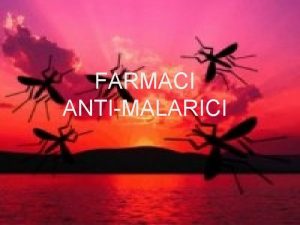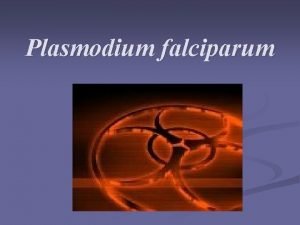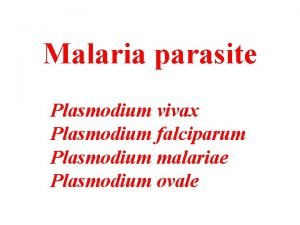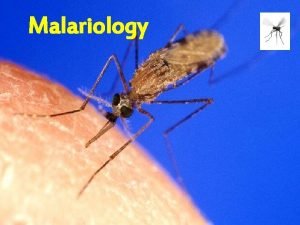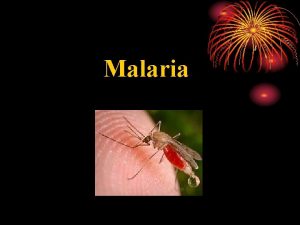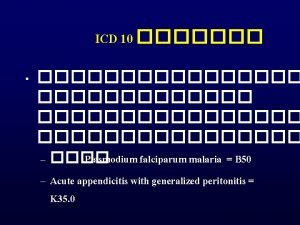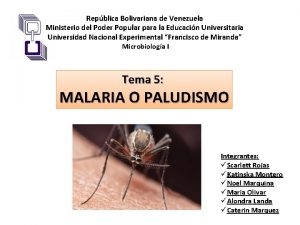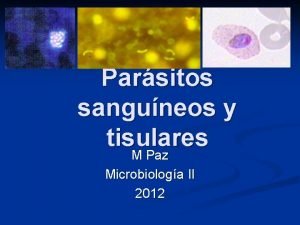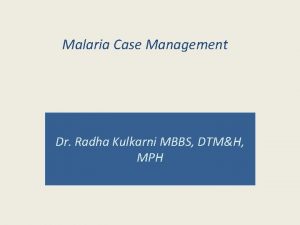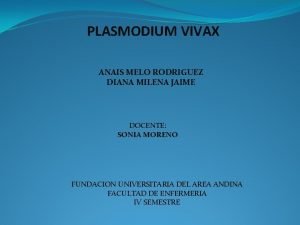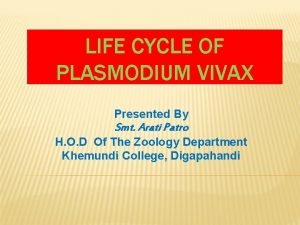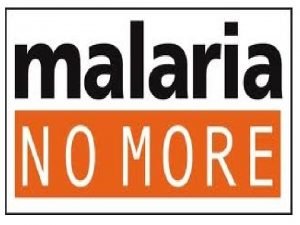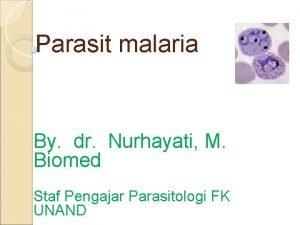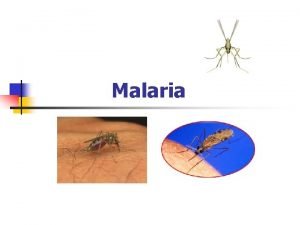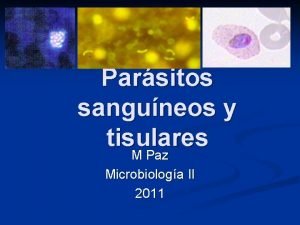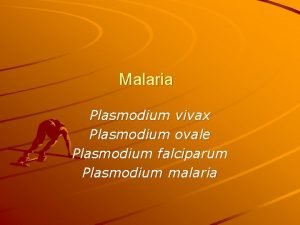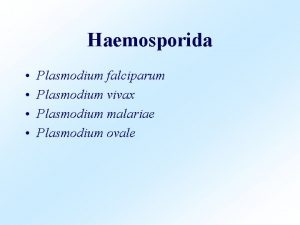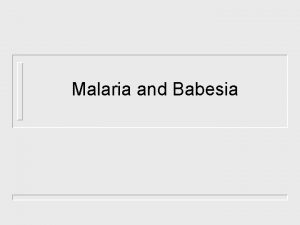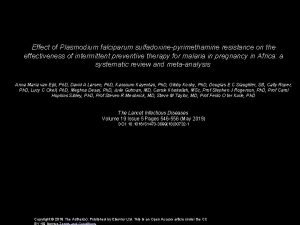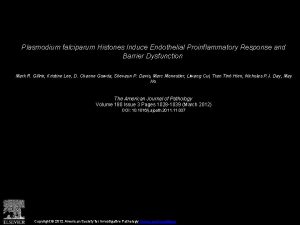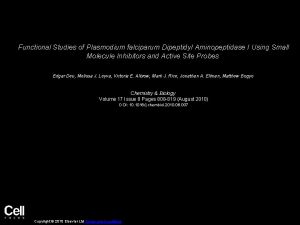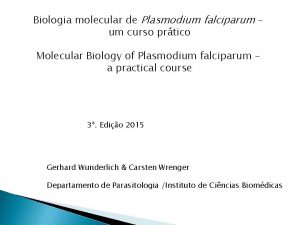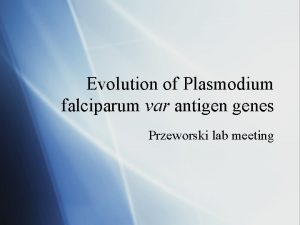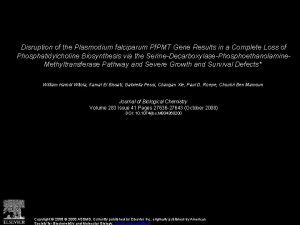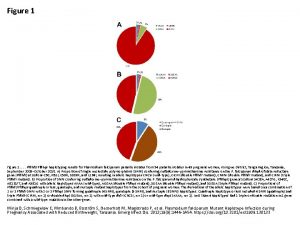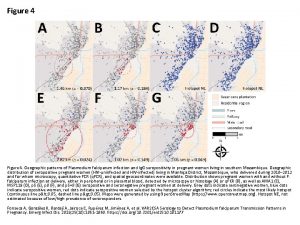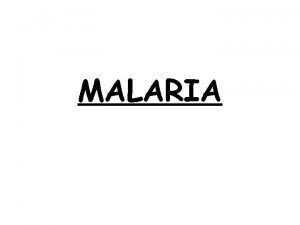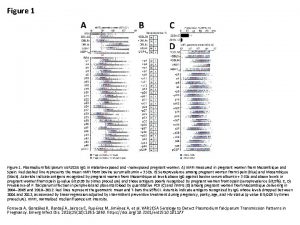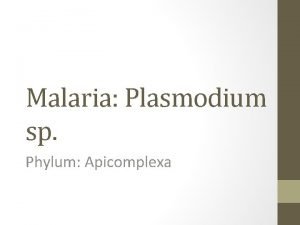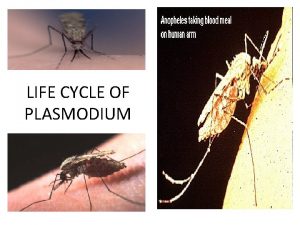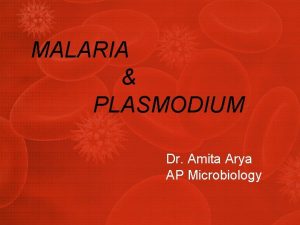Genetic Signals of Plasmodium falciparum Reveal Transmission Dynamics

























- Slides: 25

Genetic Signals of Plasmodium falciparum Reveal Transmission Dynamics and Track Infections Sarah K. Volkman

GENETIC SURVEILLANCE ACROSS TRANSMISSION LEVELS Figure from Gates Foundation: Genomic Epidemiology

Measure Transmission Detect changes in transmission and the impact of interventions on transmission Parasite Relatedness and Connectivity Determine the sources of infection and distinguish between local and imported infections Drug Resistance Surveillance Detect and monitor resistance to drugs and insecticides

GENETIC DIVERSITY & TRANSMISSION INTENSITY

GENETIC RELATEDNESS—IDENTITY BY DESCENT • Identical By Descent (IBD) alleles come from common ancestor. Identity By Descent (IBD) • Identical By State (IBS) alleles are genetically the same. • IBD accounts for meiotic recombination. • Requires ~100 – 200 informative markers. • Methods to estimate IBD from IBS. • Probability that an allele is IBD is a metric of genetic relatedness. Relatedness = 0. 25 Identity By State (IBS) Relatedness = 0. 50 Aimee Taylor, Wednesday

GENETIC RELATEDNESS—IDENTITY BY STATE • Molecular barcode genotyping. • Barcode only informative at >0. 95 relatedness • Barcode estimates IBS, but IBD can be inferred using hmm. IBD and population -specific allele frequencies. • More informative genotyping data is being obtained from natural infections. • For the purpose of this analysis relatedness is defined as >0. 95 IBS. SINGLE NUCLEOTIDE POLYMORPHISMS ü Independent ü High Minor Allele Frequency ü Discriminating Sample 1 C G A G C T G A A T C G A C T C C T A G C T Sample 2 T G G G T A G A C A A C T A T G C A A C C T Sample 3 C A A A T A C G A T A G T A C A T T C A T G A A Daniels, Malaria Journal 2008

DECLINING TRANSMISSION IN SENEGAL Stratification of malaria transmission intensity: Senegal, 2010, 2013, and 2017. Source: PNLP & Senegal: Charting the Path to Malaria Elimination, (2018), PATH Malaria Control and Evaluation Partnership in Africa [MACEPA] Estimated malaria cases: Senegal, 2005 -2017.

APPLY GENETIC SURVEILLANCE TO RANGE OF TRANSMISSION LEVELS • GREEN ZONE • Lowest incidence • Richard Toll (<1/1000) • Thiès (<5/1000) • CHALLENGES • Identify infection sources • Interpret patterns of highly related parasites Incidence per 1000 • KEY INDICATORS • Parasite relatedness • Spatiotemporal relationships • OPPORTUNITIES • Identify parasite origin • Reveal infection patterns • DECISION-MAKING • Intervention selection and targeting Malaria incidence across Senegal, 2017

INCREASED LIKELIHOOD OF POLYGENOMIC INFECTIONS FROM TRAVELERS LOW TRANSMISSION REGION: RICHARD TOLL Monogenomic Polygenomic 350 300 Number of Parasites 250 Individuals with recent travel history are more likely to have polygenomic infections. 200 150 28. 2% 100 20. 1% 50 0 Travel No Travel Fisher Exact Test, One-Tailed, p = 0. 03

EVIDENCE FOR IMPORTED INFECTIONS LOW TRANSMISSION REGION: RICHARD TOLL Twenty-one percent (21%) of Richard Toll are related to Thiès parasites. Identical parasites detected in Richard Toll and Thiès consistent with importation.

EVIDENCE FOR LOCAL INFECTIONS LOW TRANSMISSION REGION: RICHARD TOLL 9 P = 0. 01 8 Genetically similar (concordant) infections are more likely within households with no travel history. Households (n) 7 6 5 4 3 2 1 0 Concordant Discordant No Travel Genetic data can differentiate local verses imported infections, including at household level.

EVIDENCE FOR LOCAL INFECTIONS LOW TRANSMISSION REGION: RICHARD TOLL Identical parasites persisting across multiple years suggests local transmission.

TRANSMISSION DYNAMICS & PERSISTING INFECTIONS TRANSITION FROM MODERATE TO LOW TRANSMISSION: THIES Track patterns of highly related parasites within the population, consistent with inbreeding Persistence of identical parasite barcodes across transmission seasons 2006 0. 07 2008 2010 2012 Fraction of IBS >0. 95 0. 06 0. 05 0. 04 0. 03 0. 02 0. 01 0. 00 2006 2007 2008 2009 2010 2011 2012 2013 2014 2015 2016 2017 2018 Use modeling to interpret observed changes in parasite population structure. 2014 2016 2018

EPIDEMIOLOGICAL MODELING OF SENEGAL GENETIC DATA ALBERT LEE • Investigating transmission trends: detect transmission declines and rebounds • Reveal spatio-temporal trends of malaria transmission in Thiès, Senegal CGATATG CTCAATG CGCTATG CGATATG

DETECTING RELATEDNESS IN LOWEST TRANSMISSION CONTEXT—HAITI SETH REDMOND Malaria in Haiti: Genomic Epidemiology at the Lower Limits of Transmission 3 different methods of genotyping bloodspots from malaria +ve patients. What can we learn from each genotyping method in a region of extremely low diversity? Session: • Understanding genomic surveillance data and implications for malaria elimination • Weds 11: 00 -12: 15, Juniper Seth Redmond HSPH / Broad Institute / Monash University

APPLY GENETIC SURVEILLANCE TO RANGE OF TRANSMISSION LEVELS HIGH BURDEN • RED ZONE • Highest incidence • Kédougou (>450/1000) • CHALLENGES • High complexity of infection Incidence per 1000 • KEY INDICATORS • Parasite relatedness • OPPORTUNITIES • Intervention impact evaluation • DECISION-MAKING • Intervention impact • Effective intervention combinations Malaria incidence across Senegal, 2017

GENETIC MEASURES OF TRANSMISSION TO ASSESS IMPACT OF INTERVENTIONS KÉDOUGOU, SENEGAL Changes in parasite relatedness as early indicator of intervention impact on transmission.

APPLY GENETIC SURVEILLANCE TO RANGE OF TRANSMISSION LEVELS • YELLOW ISLAND • High incidence in “sea of green” • Diourbel (~100/1000) • CHALLENGES • Isolated demography (religious schools) • Historically difficult to deploy interventions Incidence per 1000 • KEY INDICATORS • Complexity of Infection • Parasite relatedness • Spatiotemporal relationships • OPPORTUNITIES • Identify parasite origin • Reveal infection patterns • DECISION-MAKING • Intervention selection and targeting Malaria incidence across Senegal, 2017

SHARED PARASITES ACROSS GEOGRAPHY

LARGER PROPORTION OF SHARED PARASITES FROM DIOURBEL Percentage of parasites within barcode clusters, by site (2018) Large proportion (47%) of Diourbel parasites share genotype with another parasite.

CHALLENGES FOR EPIDEMIOLOGICAL MODELING OF GENETIC DATA • CHALLENGES • Population-level genetic data of clinic samples THIES • Aggregated epidemiological data • OPPORTUNITIES • Interpretation of genetic signals requires finescale mapping • Develop fine spatial maps of population and infections across catchments • Align genetic and epidemiological data • Capture samples across seasonality THIES

INTEGRATING GENETICS, EPIDEMIOLOGY, MAPPING AND MODELING Ø Senegal is creating a genetic epidemiology map of the entire country. Ø Bringing routine data, risk mapping, and genetic epidemiology together to stratify intervention strategies for elimination. Integrating Genetics, Epidemiology, Mapping, and Modeling

GENETIC SURVEILLANCE FOR DECISION-MAKING Surveillance and Sampling Design Community Engagement Data Generation Data Analysis Review Decision Making Implementation Interventions • Transmission patterns for stratification of appropriate interventions. • Transmission metrics for intervention impact assessment. • Sources of infection for intervention targeting.

ACKNOWLEDGEMENTS Dyann Wirth Sarah Volkman Rachel Daniels Daouda Ndiaye Awa B. Deme Aida Badiane Michael Hainsworth Yakou Dieye Gnagna Dieng Philippe Guinot Caterina Guinovart Bronwyn Mac. Innis Steve Schaffner Tim Farrell Dan Hartl Doudou Sene Mouhamad Sy Richard W. Steketee Fatou B. Fall Coumba Ndoffene Diouf Julie Thwing Kathy Sturm-Ramirez Medoune Ndiop Moustapha Cisse Alioune Badara Gueye Oumar Sarr Edward Wenger Josh Proctor Albert Lee

Thanks! Merci! Jërejëf!
 Knobs plasmodium falciparum
Knobs plasmodium falciparum Ifn-gamma elisa
Ifn-gamma elisa Vivax
Vivax Maurer dots
Maurer dots Thrombocytobenia
Thrombocytobenia Malaria falciparum icd 10
Malaria falciparum icd 10 Genetic programming vs genetic algorithm
Genetic programming vs genetic algorithm Genetic drift vs gene flow
Genetic drift vs gene flow What is specation
What is specation Genetic drift vs genetic flow
Genetic drift vs genetic flow Genetic programming vs genetic algorithm
Genetic programming vs genetic algorithm Difference between communicative and informative signals
Difference between communicative and informative signals Communicative and informative signals
Communicative and informative signals Animals and human language chapter 2
Animals and human language chapter 2 Parasito plasmodium
Parasito plasmodium Plasmodium vivax forma infectante
Plasmodium vivax forma infectante Diagnosis of plasmodium vivax
Diagnosis of plasmodium vivax Parasito plasmodium
Parasito plasmodium Ciclo de vida plasmodium
Ciclo de vida plasmodium Plasmodium vivax cycle
Plasmodium vivax cycle Eukarya protista
Eukarya protista Gametosit plasmodium vivax
Gametosit plasmodium vivax Gametosit plasmodium vivax
Gametosit plasmodium vivax Epidemiology of malaria
Epidemiology of malaria Schizogoni
Schizogoni Tuberculosis cutanea
Tuberculosis cutanea
